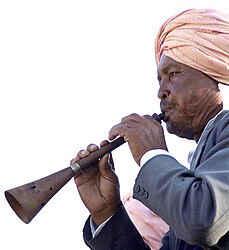| This article needs additional citations for verification. Please help improve this article by adding citations to reliable sources. Unsourced material may be challenged and removed. Find sources: "Tangmuri" – news · newspapers · books · scholar · JSTOR (February 2024) (Learn how and when to remove this message) |
 A Tangmuri player in Shillong, Meghalaya 2010 A Tangmuri player in Shillong, Meghalaya 2010 | |
| Wind Instrument | |
|---|---|
| Inventor(s) | Hynniew Trep People |
The tangmuri, ka tangmuri in the Khasi language, is a double-reed conical-bore wind-instrument used by the Hynniew Trep people of Meghalaya State in North-East India.
The tangmuri is used by musicians playing for traditional dances, and for other traditional rituals, such as cremations performed according to the indigenous religion, Niam Khasi. The tangmuri delivers a very high pitched sound when played by the musician.
Description
The instrument consists of a turned conical-bore wooden chanter, about 20 cm long, with seven finger-holes on the front, and a separate flared turned 15 cm long wooden bell which is attached to the chanter by a push-fit.
The double-reed is tied onto a thin conical-bore metal tube around 3 cm long, which is wound with thread to hold it in place in the chanter.
Gallery
References
- The Cultural Heritage of Meghalaya. United Kingdom, Manohar, 2020.
| Double reed instruments | |
|---|---|
| (also includes those with quadruple and sextuple reeds; does not include bagpipes) | |
| European classical (modern) | |
| European classical (historical) | |
| African traditional | |
| Asian traditional | |
| European traditional | |
| American traditional | |
This article relating to double-reed instruments is a stub. You can help Misplaced Pages by expanding it. |

